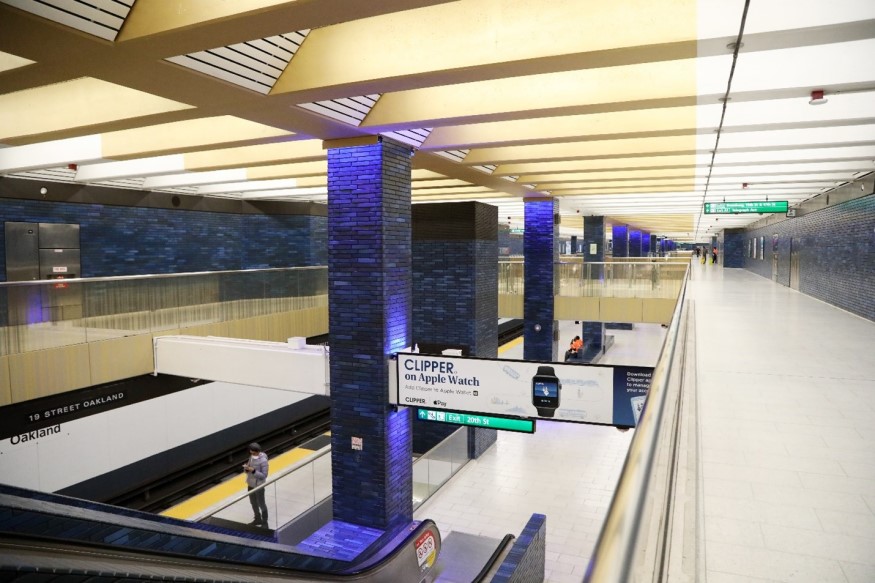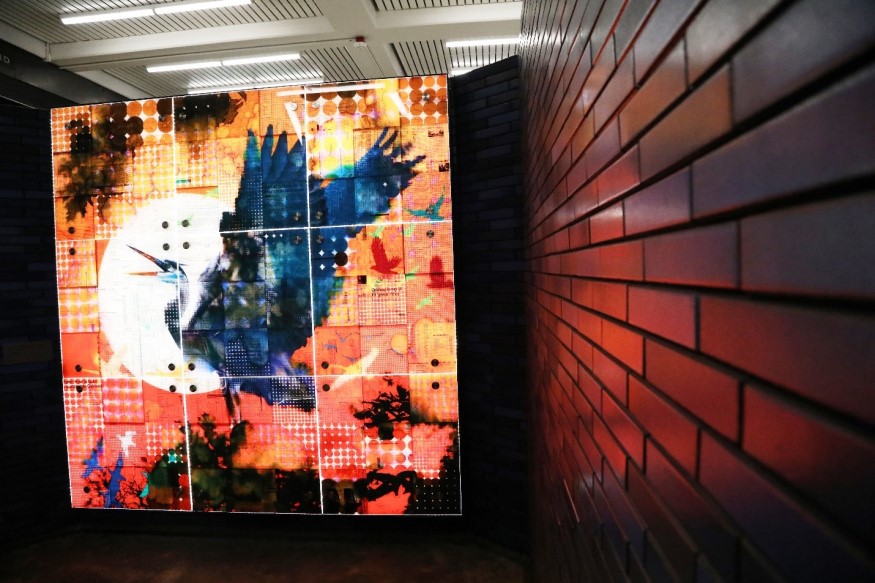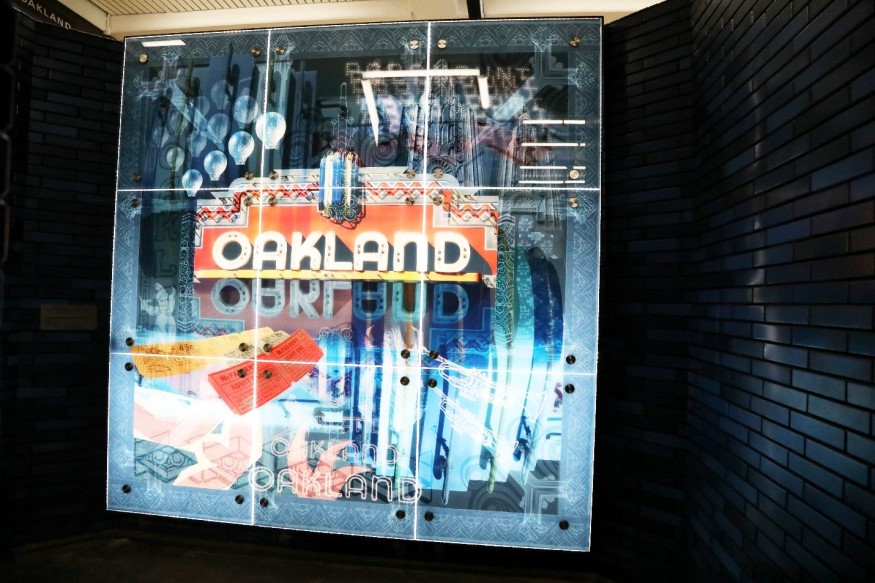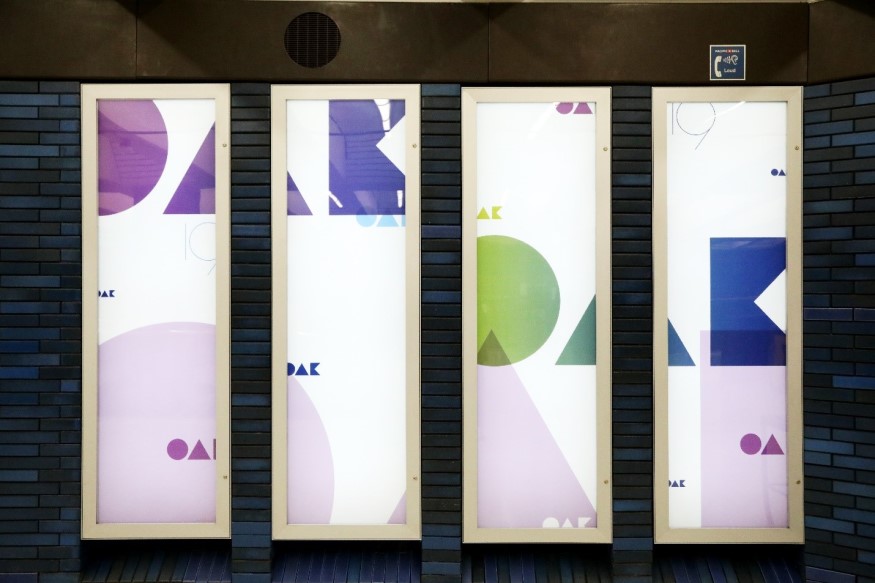Art at BART: The stories of the new artworks at modernized 19th Street Station in Oakland
 In January, BART celebrated the unveiling of a newly modernized 19th Street Station with a ribbon cutting and celebration hosted inside the gleaming Oakland destination.
In January, BART celebrated the unveiling of a newly modernized 19th Street Station with a ribbon cutting and celebration hosted inside the gleaming Oakland destination.
The station update is part of BART’s ongoing Station Modernization Program. Today, it looks and feels brighter, more expansive, and more welcoming to riders.
The upgrades to 19th Street include opening up the concourse by merging three paid areas into a single, continuous area, replacing light fixtures with energy-efficient LED lighting, expanding bike parking and adding bike stair channels, and installing new glass railing and fare barriers. You can read about all the station’s new features and enhancements here.
The station modernization also included the installation of eye-catching, thought-provoking artworks that pay homage to Oakland and its history as an arts and entertainment mecca in the West. The art portion of the project was led by Jennifer Easton, Art Program Manager at BART.
The integration of art and design began early in the project with the station planning team creating compelling opportunities. The final “Uptown” concept evolved following a significant amount of research and outreach. From there, the community supported the selection of the artists and artwork designs.
“The results make the station feel more welcoming and more Oakland,” said Easton. “We look to evolve our stations to include a sense of the surrounding neighborhood and community through art and design.”
For the overall design vision of the station, BART connected with Merge Conceptual Designs, a public art practice lead by Claudia Reisenberger that uses research-based approaches. The Merge team devised an overarching theme for the modernization and identified specific locations in the station for the integration of artwork.
Reisenberger said her team was inspired by the early- to mid-20th “environment” surrounding 19th Street, including its many ballrooms and theaters. Many of these locations are still operating today, including the Paramount and Fox theatres. One entertainment venue especially stood out to the Merge team, however: Sweet’s Ballroom, the essential Uptown Oakland venue for music and dancing during WWII’s Big Band era.
“Sweet’s was this incredibly important venue with great acoustics that opened in the 20s and became one of the best-known and most popular ballrooms in the country,” Reisenberger said, noting that the dancefloor could accommodate more than 1,000 people. The Oakland School of the Arts is now the master tenant of the Sweet’s Ballroom space.
The glamorous past of the area, exemplified by the Paramount’s vibrant gold interior, is subtly referenced throughout 19th Street. A gold curtain motif, for example, decorates the new glass railings in the center of the station.
“The railings and the ceilings of the station work together to create this kind of sparkly feel,” Reisenberger observed.
The station’s aesthetic references may not be glaringly obvious to the average rider, Reisenberger said, but they ultimately resulted in the creation of “something unique and beautiful.”
Keep reading to hear from the artists behind the new art installations.
Phillip Hua, Where To Go From Here, South Stairs
 San Francisco-based artist Phillip Hua is known for creating visual dichotomies between nature and the economy in his artwork, which often melds painting and collage with digital art.
San Francisco-based artist Phillip Hua is known for creating visual dichotomies between nature and the economy in his artwork, which often melds painting and collage with digital art.
“Putting natural elements in the same visual space as economic elements essentially makes them compete for the viewer’s attention,” Hua said. “You’re looking at one, then you’re looking at the other.”
By playing with the viewer’s attention in this way, Hua hopes to recreate the experience of “real life,” in which one must sacrifice seeing one thing in order to see another.
In Where To Go From Here, Hua’s original artwork for 19th Street, a great blue heron, perched on an oak tree and surrounded by a flock of other birds, spreads its wings against a backdrop of newspaper clippings, all of which reference Oakland’s green future and green economy, Hua said. The imagery evokes a sense of movement, inspired by the train station.
Sometimes misidentified as cranes, great blue herons are the largest herons in North America. They make their homes across the continent near shores and wetlands, including Oakland’s very own Lake Merritt.
To Hua, great blue herons are very adaptable birds, comfortable in land, sea, and air.
“I wanted that to be a symbol of Oakland – an adaptable city that changes with time and society,” Hua said.
The majestic bird with its vibrant backdrop also serves a wayfinding purpose – “Meet me in the stairway with the great blue heron!”
To create the piece, Hua made a series of digital collages, which he printed onto rice paper and then painted over. He calls his painting style a “sort of modernization of Asian brush painting” in that it references the artform’s style and compositional elements.
When the painting aspect was complete, Hua rescanned the collages and stitched them together. His last step was adding the financial graphs and newspaper clippings.
Hua, who has created art for a variety of public spaces, believes public art can serve as a conduit for hopefulness and change.
“The beauty of art is that it can shine light on issues and persuade or help people think differently about something,” he said.
Hailey and Lisa Banks, Waxed for Dancing, Central Stairs
 In initial project discussions, the design team for the station modernization frequently referenced Sweet’s Ballroom, as noted above. Artists Hailey and Lisa Banks were inspired. They knew they had to see the iconic dancehall for themselves.
In initial project discussions, the design team for the station modernization frequently referenced Sweet’s Ballroom, as noted above. Artists Hailey and Lisa Banks were inspired. They knew they had to see the iconic dancehall for themselves.
The Bankses reached out to the Oakland School of the Arts, and the school’s kindly facilities manager handed them the keys. The artists spent an entire day exploring the space and relishing in its history.
“Even when there’s nobody in the building, you can feel the history,” said Hailey. “It was this amazing experience where it felt like the spirits were with us.”
Lisa said she and Hailey “really responded to the ballroom’s architecture, especially the design elements in the ceiling.” Those elements eventually provided the basis for the design of their artwork, Waxed for Dancing. They even incorporated old admission tickets found in the ballroom’s attic.
For their piece, the artists aimed to “evoke the feeling of getting off BART at 19th Street and going to a show, while all these sights and sounds wash over you.”
Sweet’s Ballroom provided the guiding “thread” for the artwork, while the Fox Theater sign serves as the dominant focal point. In creating the piece – a process that took more than 200 hours – the Bankses worked at scale. They said the process came together organically.
“We took a ton of photos of the Fox and the Paramount and Sweet’s, looked at everything, then decided how to put it into a composition that tells a story about the neighborhood,” Lisa Banks said.
As part of the process, the artists created a playlist that featured music by some of the astonishing performers who played Oakland, Duke Ellington, Dizzy Gillespie, and Frank Sinatra among them.
“Downtown Oakland has such a rich past and present,” said Hailey. “We were trying to extend that to the future. Come on down to Downtown Oakland!”
Ron Moultrie Saunders, Yellow Daisy, North Stairs
 Every piece by San Francisco artist Ron Saunders begins the same way: research, research, research.
Every piece by San Francisco artist Ron Saunders begins the same way: research, research, research.
To Saunders, that means “getting a sense of the neighborhood, the people there, and the history.”
Before creating his striking artwork, Yellow Daisy, Saunders started by walking around Uptown Oakland. The architecture of the neighborhood, especially its many Art Deco buildings, inspired him.
“On all the Art Deco buildings, there’s some sort of botanic imagery, including the Fox, the Paramount, and the old I. Magnin Building,” Saunders observed.
That observation sparked something in the artist, who explores the natural world and its significations in much of his work.
“It struck me when looking at the Fox that there are a lot of pointed elements in the flowers the architects chose,” he remarked. “So I said to myself, ‘I think I know a plant that will work!’”
Saunders’ initial design featured a grid of plants in a variety of colors, but the piece’s busyness didn’t work for him. He decided to focus on a single plant instead – the evocative yellow daisy.
“I thought it would be easy to use it as a wayfinding mechanism,” he said. “You’ll always know the stairway with the yellow daisy.”
Saunders’ creates what are known as “photograms”: photographs made without the use of a camera. To create one, Saunders lays a plant – or plants – on the surface of a silver-based photographic paper. He then exposes that paper to light from a darkroom enlarger, which creates a “shadowy silhouette image.”
“This 19th-century process has an immediacy, rawness, and truth that is not found in images created with a camera,” Saunders said. “My artistic focus looks at ways to promote dialogue around issues concerning cultural history and how we are connected to the natural environment.”
For his Yellow Daisy, Saunders scanned the black-and-white silver print and increased its contrast to make the flower’s color pop. The blue background of the piece complements the yellow of the daisy, as well as the tile in the station.
“Photograms are a way for me to explore the essence of life, and it also encourages people to look at the natural world more closely,” Saunders said. “We have these cut flowers in a vase, and we appreciate their beauty, but there’s also beauty as the flowers fade.”
Julio Martínez of Studio1500, Kiosk Displays, Concourse
 As part of the modernization, 19th Street’s old pay phone alcoves were transformed into movie-kiosk-like displays that will feature rotating artworks.
As part of the modernization, 19th Street’s old pay phone alcoves were transformed into movie-kiosk-like displays that will feature rotating artworks.
The first pieces to grace these new displays were created by San Francisco design firm Studio1500. The project was led by Studio1500 founder Julio Martínez.
Martínez said the goal for the installation was to bring more light into the space. He said the designers repeatedly asked themselves: “How do we reinforce the idea of light and bright?” As mentioned above, 19th Street underwent a lighting makeover with the installation of energy-efficient LED fixtures, which significantly enliven the station and enhance safety.
The kiosks are located at four different locations, so Martínez and his team endeavored to make the installations cohesive. Each location features the same typographical artwork in different “lead colors,” ranging from orange to green to purple.
Martínez said his studio is “very rooted around typographic principles.” For this project, the team decided to use custom letter forms that make “very simple geometric allusions to Oakland and 19th Street.”
Before starting the pieces, Martínez spent time at 19th Street Station and contemplated the empty phone alcoves. From there, it was a matter of “creating continuity between the installations, implying movement,” he said.
“That’s where the inspiration for the pieces came from: How do we make seven panels feel like they’re glimpses of the same scene, and that scene is dynamic and moving?” Martínez concluded.
BART has included original artwork in its stations since the beginning. Today, the BART art collection is comprised of nearly 50 artworks in a variety of media. To learn more about the BART Art Program, visit this link. Read previous Art at BART features here and here.
Artists interested in learning of upcoming opportunities with the BART Art Program should sign-up to the program mailing list: https://cloud.info.bart.gov/signup. Search under “Other - BART Art Program” when you are asked for the information you’d like to receive.
Improvements to 19th Street Station were funded by State of California Proposition 1B funds, BART Measure RR funds, Caltrans (STIP) funds, Alameda CTC Measure BB funds, and a Federal Department of Transportation TIGER Grant, as part of the broader GO Uptown project with the City of Oakland.